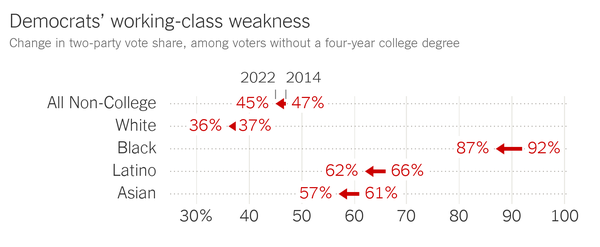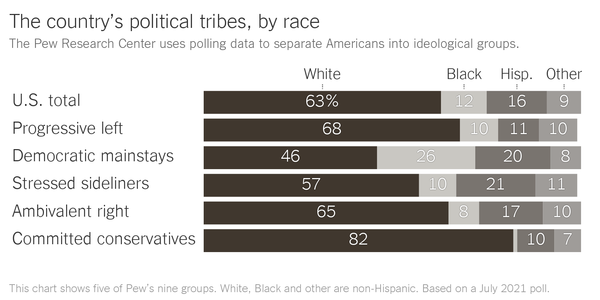The racial polarization of the parties is narrowing. People of color are less and less, rock solid Democrats. Republicans aren't just whites. To me, that's a good thing, even if it may be for frustrating reasons, and bad news if you're dreading another Trump presidency. Politics are already extremely nasty, but at least it's less and less of an appearance of a "race war".
Sparked by today's morning newsletter:
We’re covering the rightward shift among voters of color.
After Donald Trump won the presidency in 2016, many political scientists and pundits came forth with a simple explanation. Trump had won, they said, because of white Americans’ racial resentment.
These analysts looked at surveys and argued that the voters who had allowed Trump to win were distinguished not by social class, economic worries or any other factor but by their racial fears. “Another study shows Trump won because of racial anxieties — not economic distress,” as a typical headline, in The Intercept, put it.
I never found this argument to be persuasive. Yes, race played a meaningful role in Trump’s victory, given his long history of remarks demeaning people of color. But politics is rarely monocausal. And there were good reasons — including Barack Obama’s earlier success with Trump voters — to believe that the 2016 election was complex, too.
Eight years later, the “it’s all racial resentment” argument doesn’t look merely questionable. It looks wrong.
In each group, the trend is pronounced among working-class voters, defined as those without a four-year college degree. (The Democrats’ performance among nonwhite voters with a college degree has held fairly stable.)
Image

If anything, Democrats’ weakness among voters of colors appears to have intensified since 2022. Among white voters, President Biden has about as much support as he did four years ago, Nate Cohn, The Times’s chief political analyst, has pointed out. But Biden’s support among Black, Hispanic and Asian voters has plummeted. (My colleagues Jennifer Medina and Ruth Igielnik focused on the Latino shift in a recent article.)
This chart compares the 2020 results with the findings from the most recent New York Times/Siena College poll:
Image

Credit...By The New York Times | Sources: Catalist (2020) and New York Times/Siena College poll (2024)
As John Burn-Murdoch, the chief data reporter at The Financial Times, wrote last week: “I think this is simultaneously one of the most important social trends in the U.S. today, and one of the most poorly understood.”
This newsletter is the first of a two-part series about the development. Today, I hope to convince you that the trend is real and not simply, as some Democrats hope, a reflection of inaccurate poll numbers. In part two, I’ll look more closely at the likely causes.
But the evidence for the trend is much stronger than the 2024 polls. A decade ago, many Democrats assumed that the extremely high levels of support they received from voters of color during Obama’s presidency would continue. They haven’t. In 2022, for instance, the party’s disappointing performance among nonwhite voters helped Republicans win the national popular vote in House elections. This year, Biden may need to improve on the party’s 2022 showing — which would be vastly different from what polls now show — to win re-election.
“There’s been a lot of whistling past the graveyard about this,” Nate Silver wrote in his newsletter about the trend. “Dems ought to invest more time in figuring out why this is happening instead of hoping that the polls are skewed.”
The most helpful frame is social class. In many ways, the rightward shift of voters of color is surprising, given this country’s history of racial politics. I certainly did not expect the Trump era to feature a narrowing of racial polarization.
But when viewed through a class lens, the shift makes more sense. In much of the world, working-class voters, across racial groups, have become attracted to a populism that leans right while sometimes including left-wing economic ideas, such as trade restrictions. This populism is skeptical of elites, political correctness, high levels of immigration and other forms of globalization.
Today’s populists “are more diverse than the stereotypical ‘angry old white men’ who, we are frequently told, will soon be replaced by a new generation of tolerant Millennials,” Roger Eatwell and Matthew Goodwin, two British scholars of politics, have written. Indeed, Democrats today particularly struggle with young voters of color, Nate Cohn has explained.
The old racial-resentment story about Trump’s victory was alluring to many progressives because it absolved them of responsibility. If Trump’s appeal was all about racism, there was no honorable way for Democrats to win back their previous supporters.
The true story is both more challenging and more hopeful. The multiracial, predominantly working-class group of Americans who have soured on mainstream politics and modern liberalism are not all hateful and ignorant. They are frustrated, and their political loyalties are up for grabs.
Sparked by today's morning newsletter:
Race and Politics
We’re covering the rightward shift among voters of color.
After Donald Trump won the presidency in 2016, many political scientists and pundits came forth with a simple explanation. Trump had won, they said, because of white Americans’ racial resentment.
These analysts looked at surveys and argued that the voters who had allowed Trump to win were distinguished not by social class, economic worries or any other factor but by their racial fears. “Another study shows Trump won because of racial anxieties — not economic distress,” as a typical headline, in The Intercept, put it.
I never found this argument to be persuasive. Yes, race played a meaningful role in Trump’s victory, given his long history of remarks demeaning people of color. But politics is rarely monocausal. And there were good reasons — including Barack Obama’s earlier success with Trump voters — to believe that the 2016 election was complex, too.
Eight years later, the “it’s all racial resentment” argument doesn’t look merely questionable. It looks wrong.
Skewed polls?
Since Trump’s victory, a defining feature of American politics has been the rightward shift of voters of color. Asian, Black and Hispanic voters have all become less likely to support Democratic candidates and more likely to support Republicans, including Trump.In each group, the trend is pronounced among working-class voters, defined as those without a four-year college degree. (The Democrats’ performance among nonwhite voters with a college degree has held fairly stable.)
Image

If anything, Democrats’ weakness among voters of colors appears to have intensified since 2022. Among white voters, President Biden has about as much support as he did four years ago, Nate Cohn, The Times’s chief political analyst, has pointed out. But Biden’s support among Black, Hispanic and Asian voters has plummeted. (My colleagues Jennifer Medina and Ruth Igielnik focused on the Latino shift in a recent article.)
This chart compares the 2020 results with the findings from the most recent New York Times/Siena College poll:
Image

Credit...By The New York Times | Sources: Catalist (2020) and New York Times/Siena College poll (2024)
As John Burn-Murdoch, the chief data reporter at The Financial Times, wrote last week: “I think this is simultaneously one of the most important social trends in the U.S. today, and one of the most poorly understood.”
This newsletter is the first of a two-part series about the development. Today, I hope to convince you that the trend is real and not simply, as some Democrats hope, a reflection of inaccurate poll numbers. In part two, I’ll look more closely at the likely causes.
Young populists
It’s true that polls are not the same as elections, and Biden may improve his standing by November. With far more campaign cash than Trump, Biden will have a chance to frame the election as a choice between the two, rather than a referendum on the country’s condition.But the evidence for the trend is much stronger than the 2024 polls. A decade ago, many Democrats assumed that the extremely high levels of support they received from voters of color during Obama’s presidency would continue. They haven’t. In 2022, for instance, the party’s disappointing performance among nonwhite voters helped Republicans win the national popular vote in House elections. This year, Biden may need to improve on the party’s 2022 showing — which would be vastly different from what polls now show — to win re-election.
“There’s been a lot of whistling past the graveyard about this,” Nate Silver wrote in his newsletter about the trend. “Dems ought to invest more time in figuring out why this is happening instead of hoping that the polls are skewed.”
The most helpful frame is social class. In many ways, the rightward shift of voters of color is surprising, given this country’s history of racial politics. I certainly did not expect the Trump era to feature a narrowing of racial polarization.
But when viewed through a class lens, the shift makes more sense. In much of the world, working-class voters, across racial groups, have become attracted to a populism that leans right while sometimes including left-wing economic ideas, such as trade restrictions. This populism is skeptical of elites, political correctness, high levels of immigration and other forms of globalization.
Today’s populists “are more diverse than the stereotypical ‘angry old white men’ who, we are frequently told, will soon be replaced by a new generation of tolerant Millennials,” Roger Eatwell and Matthew Goodwin, two British scholars of politics, have written. Indeed, Democrats today particularly struggle with young voters of color, Nate Cohn has explained.
The old racial-resentment story about Trump’s victory was alluring to many progressives because it absolved them of responsibility. If Trump’s appeal was all about racism, there was no honorable way for Democrats to win back their previous supporters.
The true story is both more challenging and more hopeful. The multiracial, predominantly working-class group of Americans who have soured on mainstream politics and modern liberalism are not all hateful and ignorant. They are frustrated, and their political loyalties are up for grabs.



